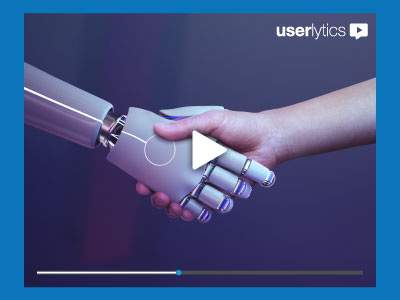When conducting UX research, the quality of your insights is only as strong as the participants you recruit. The temptation is always there: fill sessions quickly with people who are eager to sign up, available on short notice, and motivated by incentives.
At first glance, this might feel efficient because it reduces recruitment time and ensures that every testing slot is covered. What could possibly go wrong?
However, there is a hidden risk. If most of your participants are what the industry calls “professional testers” or “proxies,” the insights you collect can become misleading, biased, or simply disconnected from the everyday experiences of real customers.
Professional testers are people who are dedicated to testing user experiences and who participate in so many studies that they begin to ‘game the system.’ Instead of representing genuine users, they act more like consultants. They usually know exactly what researchers want to hear, so as to be called again and again. Their feedback often sounds polished, structured, or overly technical, but it lacks the raw authenticity that true customers bring and that companies want.
This creates a dangerous gap: products may end up being designed or optimized based on synthetic feedback rather than the lived frustrations, needs, and enjoyments of their intended audience.
Authenticity in UX testing is not just a nice-to-have, it’s central to creating digital products that resonate. Our research and methodologies highlight how real participant profiles drive more reliable user sentiment measurement, while skewed profiles introduce noise that weakens decision-making.
In other words, if your test participants don’t reflect the demographics, behaviors, and motivations of your target audience, your results may be incomplete and at worst, harmful to your product roadmap.
That’s why learning to identify, filter, and avoid professional testers is a crucial skill for UX teams. By doing so, you protect the integrity of your research and ensure that every design decision is based on the perspectives of the people who will ultimately decide whether your product succeeds in the market.

Vía Freepick.com
What is a Professional Tester in UX Research
In the world of UX research, the term “professional tester” refers to participants who no longer behave like everyday users but instead treat usability testing as a side job. These are individuals who sign up for as many studies as possible, sometimes across multiple platforms, primarily to collect incentives.
Unlike the occasional participant who joins a study because they are curious about a product or genuinely belong to the target audience, professional testers become overexposed to the testing environment. They quickly learn how to navigate tasks in ways that please researchers rather than reflect real-world struggles. For instance, they know to speak aloud continuously, avoid silence, and give “balanced” answers that sound thoughtful but may not come from actual UI experiences.
Another common characteristic is their technical or insider background. Many professional testers are developers, designers, QA specialists, or digital professionals. While this gives them the ability to spot usability issues quickly, it also means they evaluate with a lens that regular users simply do not have. Instead of stumbling over confusing navigation, they might suggest code-level improvements. Instead of admitting frustration, they frame issues as hypothetical fixes. This transforms the session from a user test into an expert review. That, although useful in some contexts, can be misleading when the goal is to capture authentic user experience.
Unknowingly, their polished, confident feedback can trick teams into thinking they’ve uncovered deep insights. This kind of feedback is not representative of your target audience. Everyday customers rarely articulate usability problems in neat UX terminology. They express confusion, annoyance, or delight in raw, emotional terms. Those are the kind of signals that truly help product teams improve design.

Vía Freepick.com
The Difference Between Vetted Testers and “Professional Testers”
It’s worth clarifying an important distinction. When we talk about professional testers, we’re referring to participants who take part in dozens of studies mainly for incentives, often shaping their responses around what they think researchers want to hear. These participants can unintentionally distort results by approaching tests as experts rather than as genuine users.
However, experienced or vetted testers are not the same thing. Many platforms rely on vetted participants who have been carefully screened, verified, and rated for the quality of their feedback. In this way, their experience often helps moderated sessions run smoothly, as they understand how to communicate clearly, follow instructions, and stay focused on the task.
A vetted tester who matches the target profile and provides honest, thoughtful feedback can add real value to your user research needs. The risk comes from overexposed testers who misrepresent themselves or treat every test as a performance. That’s why trusted research providers use verification systems, behavioral screening, and quality scoring to ensure that even experienced participants still represent real users and deliver meaningful insights.
Why Avoid Professional Testers?
Having made the previous disclaimer, avoiding professional testers is not about questioning their intentions, it’s about protecting the validity of your research. Allowing too many into your studies can distort results in three main ways.
1. Skewed Insights
Instead of uncovering the spontaneous frustrations that a real user might encounter, you often hear rehearsed responses. Professional testers know the ‘script’ and provide answers they think researchers want. The outcome is data that looks neat but lacks the authenticity needed for reliable product improvements.
2. Unrealistic Expectations
Developers, UX designers, or QA specialists often hold products to expert-level standards. They may flag issues that ordinary customers would never notice or care about. Conversely, they might breeze through processes that would confuse new users, making the product appear more usable than it really is.
3. Wasted Resources
Acting on inaccurate or biased feedback can push design teams to prioritize the wrong improvements. This leads to wasted development time, misaligned product roadmaps, and in some cases, lower adoption rates because changes were based on the wrong user perspective.
In contrast, real users bring what researchers value most: fresh, unfiltered perspectives. They expose the actual pain points, emotional reactions, and small delights that shape the everyday customer journey. They stumble, get confused, and sometimes surprise us with creative ways of solving problems. These insights simply don’t surface when the participant is acting like an “expert tester.”
Ultimately, the choice of participants determines whether your UX research delivers actionable truth or polished fiction.
Keep in mind, you don’t have to do it all on your own. At Userlytics, we address this common challenge through our UX Consulting services. This specialized team offers support with recruitment, screening, and participant validation on behalf of clients.
Additionally, our team continuously monitors participation patterns, verifies user authenticity, and applies strict screening criteria to ensure that each study includes real, representative users rather than overexposed testers. This type of quality management helps maintain the integrity of the insights and protects the research from bias.
How to Spot and Prevent Professional Testers
If you want your UX insights to truly reflect how real customers think, behave, and feel, you must put in place a comprehensive recruitment strategy. That strategy should ensure participants represent your target audience and aren’t simply joining sessions for incentives or because they already know how to “play the testing game.”
Here are proven strategies to keep your participant pool authentic:
1. Smart Screening
A well-designed screener survey can be your first line of defense. Instead of just asking for basic demographics, go deeper: ask about product usage frequency, specific behaviors, or situations where the product might realistically be used. For example, instead of asking “Do you shop online?” you might ask, “What was the last product you bought online, and from which site?”
Additionally, adding “red flag” questions, like inconsistent options or ones that require short open-text answers, helps expose participants who are faking expertise or exaggerating their fit.
2. Frequency Control
One of the clearest signs of a professional tester is over-participation. If a participant is joining multiple studies every week, their perspective is no longer fresh. They become desensitized to usability issues and start approaching every test as an “exercise” instead of a genuine interaction with the product.
By setting rules that limit how often someone can participate (for example, not more than once a month), you reduce the risk of bias from overexposed users. Some platforms, including Userlytics, apply frequency filters to maintain a pool of participants who haven’t been “trained” by repeated testing.
3. Diverse Recruitment Channels
While relying solely on generic testing panels can increase the risk of “professional testers,” not all panels are created equal. Some are actively curated, with controls that filter out over-exposed participants and validate real usage contexts. You can effectively use a well-managed panel as a foundation and, if you consider your study to need it, complement it with other recruitment channels, such as inviting your own customers or engaging with niche communities that represent your target audience.
This balance ensures you get both the speed and reach of a global panel, and the authenticity that comes from voices directly connected to your product or market.
Here are some ways to find your own participants:
- Social media ads that target specific demographics.
- Customer lists of people who already use your product.
- Niche communities or forums where your audience spends time (e.g., parenting groups, fitness communities, financial forums).
- Loyalty programs where participation can be rewarded with perks beyond cash incentives.
This mix not only lowers dependence on experienced testers but also introduces participants with more realistic and varied backgrounds.

Vía Freepick.com
4. Context Validation
When participants claim product familiarity, ask for concrete examples. If someone says they are a frequent user of a banking app, you might ask: “What is the last action you completed in the app?” or “What feature do you use most often, and why?”.
Professional testers often fail this kind of validation, giving vague or inconsistent answers. Real users, on the other hand, recall specific interactions, frustrations, or workarounds. Adding these questions during screening or at the beginning of the session ensures participants are genuinely aligned with your study’s target persona.
5. Trap Questions
Trap questions are a simple but powerful tool to filter unreliable participants. By adding an impossible or irrelevant answer option, such as listing a non-existent app or a feature your product doesn’t offer, you can quickly identify who is not paying attention or is simply winging their experience.
For example, in a screener for a streaming service, you might ask: “Which of the following platforms do you currently use?” and include fake names like “StreamHub Max.” If a participant selects it, you know they are not reliable.
Trap questions also help detect professional testers who rush through surveys without reading carefully, just to qualify for as many studies as possible.
You might also like: How To Recruit Participants For A UX Study – 9 Tips
Ensuring Authentic Insights in UX Research
The real value of UX research lies in the authenticity of the voices behind it. While professional testers may sound polished, their feedback rarely reflects the genuine experiences of everyday users.That’s why participant recruitment matters as much as research design. By combining best practices like smart screening, context validation, and frequency controls with a carefully curated participant pool, you can protect your insights from bias and uncover the insights that lead to better products.
Lookout for a panel that is actively managed, globally diverse, and designed to filter out professional testers, to get a reliable foundation for research. Combined with the option to invite your own participants or target niche communities, it ensures that the feedback you receive is not only fast and scalable, but also authentic and trustworthy.

Vía Freepick.com
Get the Real Voice of the User
Think about the last time you tried a new app or website. Maybe you felt a spark of excitement, only to get stuck on a confusing button, or maybe you smiled when something worked perfectly the first time. That’s the real voice of the user. It’s unpolished, unpredictable, and completely honest.
That’s the voice your research should capture, not the rehearsed answers of someone who’s been through dozens of tests.
So next time you’re planning a study, pause for a second. Ask yourself: Am I recruiting real people with real stories, or professional testers with practiced scripts?
Choose authenticity. Those genuine voices will guide you to build products people truly love.
Schedule a Free Demo
Userlytics

Since 2009 we have been helping enterprises, governmental organizations, non-profits, agencies and startups optimize their user experience, or UX. With our state-of-the-art platform, massive global participant panel and unlimited accounts/seats for democratizing user research, we are the best all-in-one solution for remote user testing.
Schedule a Free Demo


